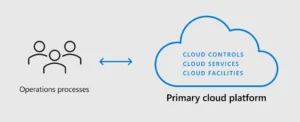Hybrid Cloud – Introduction
Hybrid Cloud Computing has revolutionized how we store, access, and manage data. There are two main types of cloud environments: public and private. Public clouds are owned and operated by third-party cloud service providers, while private clouds are dedicated resources owned and managed by an organization.
However, many businesses have realized that a single cloud model may not meet all their needs. This is where hybrid clouds come into play. A hybrid cloud is a combination of public and private cloud environments. It allows organizations to leverage the scalability and cost-effectiveness of public clouds while maintaining control and security over sensitive data and applications in a private cloud.
Imagine you run a company that handles both public-facing websites and confidential financial data. You could host your public websites on a public Cloud for easy scalability and cost savings, while keeping your sensitive financial data securely stored in a private cloud. This hybrid approach gives you the best of both worlds: the flexibility and cost benefits of public clouds, and the control and security of private clouds.
How do hybrid clouds work?
A hybrid cloud combines resources from both public and private cloud environments, allowing organizations to distribute their workloads across these different environments based on their specific needs.
In a hybrid cloud setup, the public and private cloud components are connected through a secure communication channel, often a virtual private network (VPN) or a dedicated private connection. This connection enables data and applications to move seamlessly between the two environments, ensuring a seamless user experience.
Hasons ProSync Nova
Hdmi Monitor 21.5-Inch” FHD (1920×1080) Display | Brightness: 250 Nits | VA Display 54.61 Cm (21.5 In) Widescreen Panel Active Area (W/H)67.60/26.70 Cm
Hybrid Cloud Architecture
The architecture of a involves integrating multiple cloud environments into a unified infrastructure. This typically includes the following components:

Public Cloud: The public cloud component is provided by a third-party cloud service provider, such as Amazon Web Services (AWS), Microsoft Azure, or Google Cloud Platform (GCP). These platforms offer scalable and on-demand computing resources, including virtual machines, storage, and various cloud services.
Private Cloud: The private cloud component is a dedicated cloud environment owned and managed by the organization. It can be hosted on-premises or in a third-party data center. Private clouds provide greater control, security, and customization options for sensitive or mission-critical workloads.
Hybrid Cloud Networking
Networking plays a crucial role in enabling effective communication and data exchange between the public and private cloud components of a hybrid cloud environment.
Here are some key aspects of hybrid cloud networking:
Connectivity Options: Organizations have several options for establishing connectivity between their private cloud and the public cloud, including:
Virtual Private Network (VPN): A VPN provides a secure, encrypted connection over the internet, allowing secure communication between the private and public cloud components.
Hybrid Cloud Integration
Integrating public and private cloud environments into a cohesive hybrid cloud solution can be a complex task. Effective integration is essential for ensuring seamless data and application mobility, as well as consistent management and governance across the entire hybrid cloud Infrastructure. Here are some key aspects of hybrid cloud integration:
Application Integration: Applications and workloads often need to be integrated across the public and private cloud components. This may involve containerization, microservices architecture, or the use of cloud-native applications designed to run seamlessly across different cloud environments.
Hybrid Cloud Platforms
Several major cloud providers offer hybrid cloud platforms and solutions that enable organizations to seamlessly integrate and manage their public and private cloud environments. Here are some popular hybrid cloud platforms:

AWS Outposts: AWS Outposts is a fully managed service that extends the AWS infrastructure, services, APIs, and tools to virtually any data center, co-location space, or on-premises facility. It allows organizations to run AWS services locally while maintaining a consistent experience and seamless integration with the AWS public cloud.
Microsoft Azure Stack: Azure Stack is an on-premises extension of Microsoft Azure, allowing organizations to run Azure services within their own data centers. It provides a consistent hybrid cloud experience, enabling workload portability and seamless integration between on-premises and Azure public cloud environments. Understanding the differences between public and private clouds is essential when considering a hybrid cloud approach.
Here’s a comparison of the two cloud models:
Public Cloud:
- Owned and operated by third-party cloud service providers (e.g., AWS, Azure, Google Cloud)
- Shared infrastructure and resources across multiple customers
- Pay-as-you-go pricing model, typically based on usage
- High scalability and elasticity, allowing rapid provisioning and release of resources
- Generally considered more cost-effective for variable or intermittent workloads
Private Cloud:
- Dedicated cloud environment owned and managed by the organization
- Resources are not shared with other organizations
- Can be hosted on-premises or in a third-party data center
- Provides greater control, security, and customization options
While public clouds offer scalability, cost-efficiency, and reduced management overhead, private clouds provide enhanced security, control, and compliance capabilities. Organizations must carefully evaluate their workload requirements, security needs, and budgets to determine the appropriate mix of public and private cloud resources in a hybrid cloud strategy.
Benefits of Hybrid Cloud
Flexibility and Scalability: Hybrid clouds allow organizations to leverage the scalability and elasticity of public clouds while maintaining control and security over sensitive workloads in a private cloud. This flexibility enables organizations to quickly scale resources up or down based on changing demands.
Cost Optimization: By combining public and private cloud resources, organizations can optimize their IT costs. They can take advantage of the pay-as-you-go model of public clouds for variable or intermittent workloads, while maintaining dedicated private cloud resources for consistent, mission-critical workloads.
Hybrid Cloud Security
Security is a critical consideration when adopting a strategy, as organizations must ensure the protection of their data and applications across multiple cloud environments.
Here are some key aspects of security:
Identity and Access Management (IAM): Implementing a centralized IAM solution that spans both the public and private cloud components is crucial for maintaining consistent access controls, authentication, and authorization across the hybrid cloud environment.
Hybrid Cloud Use Cases
Hybrid cloud solutions can be beneficial for organizations across various industries and use cases.
Here are some common hybrid cloud use cases:
Big Data and Analytics: Organizations can leverage the scalability and compute power of public clouds for big data processing and analytics workloads, while keeping sensitive data securely stored in a private cloud environment.
High-Performance Computing (HPC): HPC workloads, such as scientific simulations, financial modeling, and computer-aided design (CAD), can benefit from the ability to burst into the public cloud for additional compute resources when needed, while maintaining a dedicated private cloud infrastructure for sensitive or long-running workloads.
Hybrid Cloud Management Tools
Effective management and orchestration of environments are essential for ensuring efficient operations, optimized resource utilization, and consistent governance across the entire infrastructure. Several tools and platforms are available to help organizations manage their deployments:
Cloud Management Platforms (CMPs): CMPs, such as VMware v Realize Suite, Red Hat Cloud Forms, and IBM Cloud Pak for Multicloud Management, provide a centralized interface for managing and orchestrating resources across multiple cloud environments, including public and private clouds. They offer features like provisioning, monitoring, automation, and cost management.
Conclusion
As organizations strive to balance their IT needs, budgets, and security requirements, solutions have emerged as a compelling approach. By combining the scalability and cost-effectiveness of public clouds with the control and Security of private clouds, hybrid clouds offer the best of both worlds.
The journey towards adopting a strategy may involve challenges, such as integrating diverse cloud environments, ensuring data and application mobility, and implementing consistent security and governance policies. However, the benefits of a well-designed solution often outweigh these challenges.
| If you are reading Hybrid Cloud , then also check our other blogs: | |
| Computer Cooling | Desktop without CPU |
Hybrid Cloud
- What are the components of a hybrid cloud?The main components of a hybrid cloud include the public cloud component (provided by third-party cloud service providers), the private cloud component (owned and managed by the organization), secure connectivity between the two environments (e.g., VPNs, dedicated links), a unified management and orchestration layer, security and compliance controls, and technologies enabling data and application mobility.
- How does data storage work in a hybrid cloud?In a hybrid cloud environment, data can be stored and replicated across both the public and private cloud components. Organizations often keep sensitive or mission-critical data in the private cloud for enhanced security and control, while leveraging public cloud storage for less sensitive or archival data. Data replication mechanisms and hybrid data platforms enable the seamless movement of data between the two environments.
- What challenges are associated with implementing a hybrid cloud?Some of the key challenges in implementing a hybrid cloud include integrating diverse cloud environments, ensuring data and application portability, establishing consistent security and governance policies, managing complex networking and connectivity requirements, and addressing potential vendor lock-in concerns.
- What are some popular hybrid cloud solutions?Popular hybrid cloud solutions include AWS Outposts, Microsoft Azure Stack, Google Cloud Anthos, VMware Cloud, Red Hat OpenShift, and IBM Cloud Satellite. These platforms and services from major cloud providers enable organizations to extend their on-premises or private cloud environments to public cloud resources, providing a consistent hybrid cloud experience.

